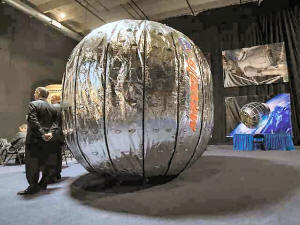|
Expandable space habitat fails to inflate
in NASA's first test
 Send a link to a friend
Send a link to a friend
 [May 27, 2016]
By Irene Klotz [May 27, 2016]
By Irene Klotz
CAPE CANAVERAL, Fla. (Reuters) - NASA
called off an attempt to inflate an experimental habitat attached to the
International Space Station after the fabric module failed to expand as
planned on Thursday.
Station crew member Jeff Williams spent more than two hours
opening a valve to allow spurts of air to inflate the 3,100-pound
(1,400 kg) module, the first expandable habitat to be tested with
astronauts in space.
But the Bigelow Expandable Activity Module, or BEAM, failed to
unfurl as expected, mission commentator Dan Huot said during a NASA
TV broadcast.
“We’ll hope for better luck tomorrow,” astronaut Jessica Meir
radioed to Williams from Mission Control in Houston.
The prototype habitat, which was flown to the station last month
aboard a SpaceX Dragon cargo ship, is made of impact-resistant,
Kevlar-like materials and flexible layers of fabric.
 NASA is interested in using expandable habitats as living quarters
for crew members in its future plans for three-year trips to and
from Mars. The lightweight habitats could save millions of dollars
in launch costs compared with metal modules. They may also offer
better radiation protection for astronauts.
BEAM was designed and built by Bigelow Aerospace, a Las Vegas-based
firm owned and operated by billionaire entrepreneur Robert Bigelow.
Now, engineers from NASA and Bigelow are studying why the habitat
failed to expand as planned. They may resume the operation on
Friday, Huot said during the NASA broadcast.
[to top of second column] |

The Bigelow Expandable Activity Module (BEAM) is seen during a media
briefing at Bigelow Aerospace in Las Vegas, Nevada, January 16,
2013. Bill Ingalls/NASA/File Photo/Handout via Reuters

NASA had hoped to expand BEAM using spurts of air from the station,
before pressurizing it to inflate to the size of a small bedroom, a
10-fold increase in volume.
NASA plans to keep BEAM attached to the station, a $100 billion
research laboratory that flies about 250 miles (400 km) above Earth,
for two years to see how it fares in the harsh environment of space.
(Editing by Letitia Stein and Bernadette Baum)
[© 2016 Thomson Reuters. All rights
reserved.]
Copyright 2016 Reuters. All rights reserved. This material may not be published,
broadcast, rewritten or redistributed.
 |